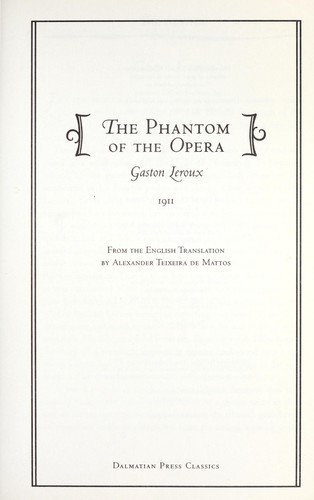276 pages
English language
Published Jan. 2, 2010 by Dalmatian Press Classics, FQ Books.

276 pages
English language
Published Jan. 2, 2010 by Dalmatian Press Classics, FQ Books.
Gaston Leroux's novel The Phantom of the Opera, first published in 1910, remained a perennial favorite throughout the twentieth century and into the early 2000s. It was adapted to several popular motion pictures and into one of the most successful stage musicals of all time. Its main character, Erik, is a romantic figure whose appeal reaches across different cultures and times. He is a sensitive soul, an accomplished composer and musician whose great unfinished work, Don Juan Triumphant, is described as breathtakingly beautiful by the one person he allows to hear it; he is an object of pity, whose face has been disfigured from birth, causing him to hide behind a silk mask; and he is hopelessly in love with a young woman whom he can never seriously hope will love him back. At the same time, he a dangerous, menacing figure, lurking in the hidden catacombs beneath the opera …
Gaston Leroux's novel The Phantom of the Opera, first published in 1910, remained a perennial favorite throughout the twentieth century and into the early 2000s. It was adapted to several popular motion pictures and into one of the most successful stage musicals of all time. Its main character, Erik, is a romantic figure whose appeal reaches across different cultures and times. He is a sensitive soul, an accomplished composer and musician whose great unfinished work, Don Juan Triumphant, is described as breathtakingly beautiful by the one person he allows to hear it; he is an object of pity, whose face has been disfigured from birth, causing him to hide behind a silk mask; and he is hopelessly in love with a young woman whom he can never seriously hope will love him back. At the same time, he a dangerous, menacing figure, lurking in the hidden catacombs beneath the opera house and blackmailing those who will not bow to his whims. He can hear things said in privacy and can create catastrophes that might or might not be the accidents that they seem to be.